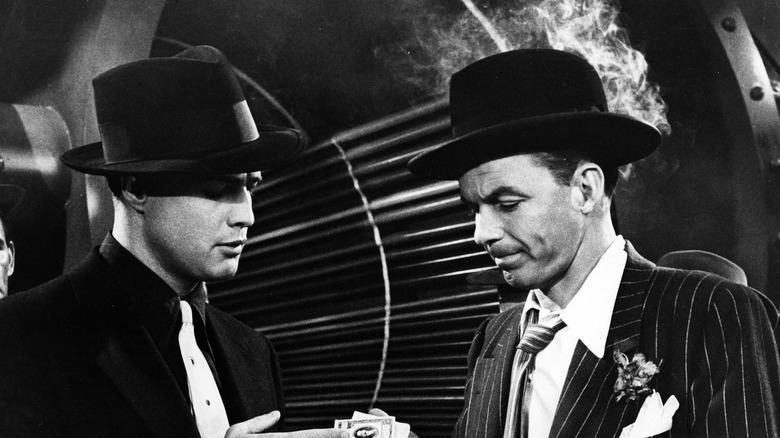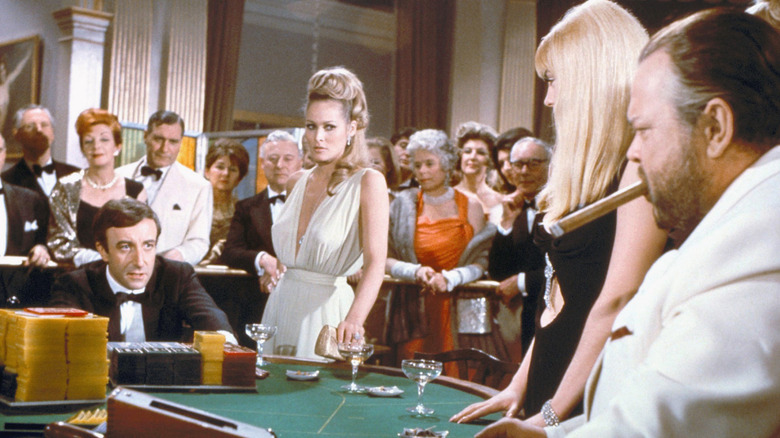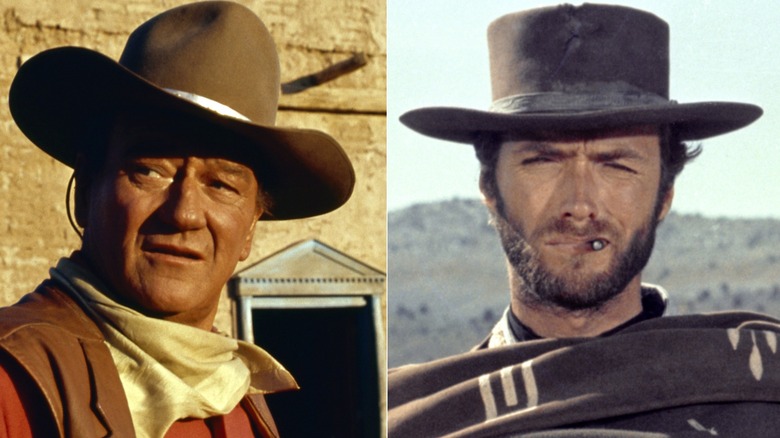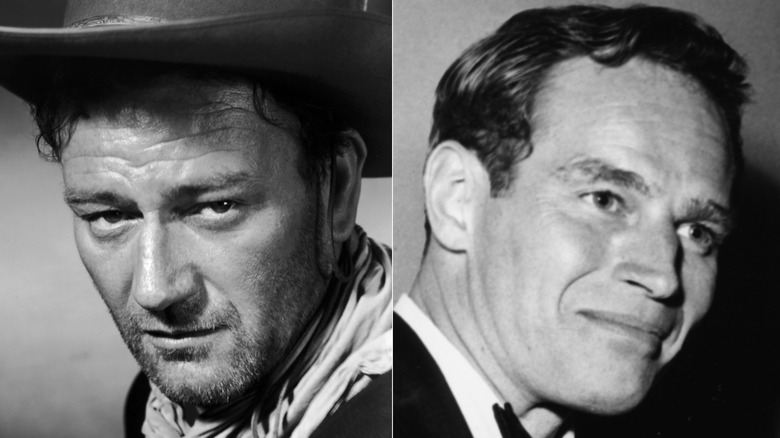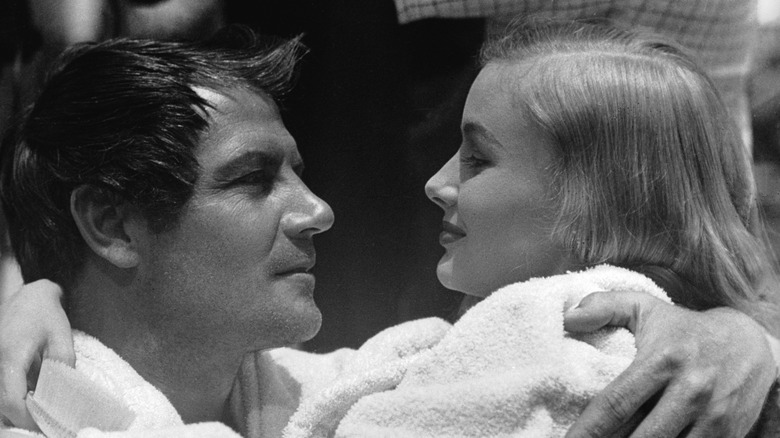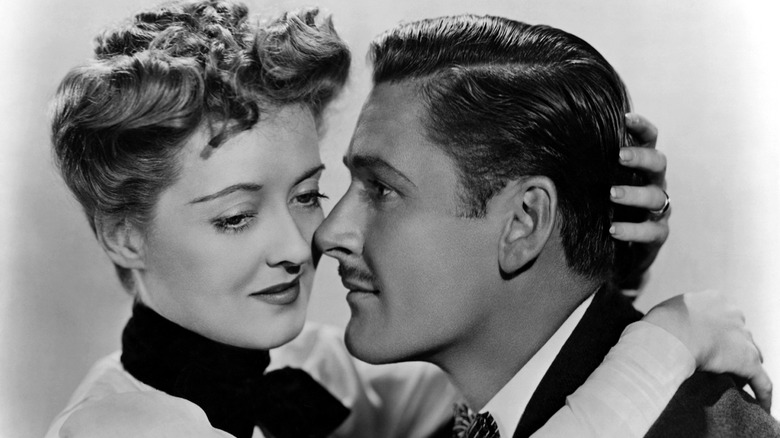Old Hollywood Actors Who Refused To Work Together
In February 2023, on the "New Rule" segment of his show "Real Time," comedian Bill Maher suggested that members of Congress take a page from the book of Hollywood. After highlighting the increasing partisan tension in Washington, D.C. and the physical altercations that have broken out in legislatures elsewhere, Maher said that he doubted Republicans and Democrats could come together with a new sense of love and brotherhood. Instead, Maher offered what he called a fundamental rule of show business: "You can get great things done and still hate each other's f****** guts."
The rest of the monologue was devoted to examples of major Hollywood productions that won popular and critical renown despite tensions between co-stars and filmmakers. Maher isn't wrong: Great films can come about despite hostile relations among the creative team. But none of the examples he listed involved relationships so sour that co-stars literally refused to work together. Yet they exist too.
Actors who wouldn't share a stage or even a room with one another aren't exclusive to contemporary film either. The stars of the Old Hollywood had their own feuds, some of which left producers and directors with the logistical puzzle of shooting with two leads who refused to work together. Here's a look at a few of those near-disasters — and how the movies got made anyway.
Frank Sinatra and Marlon Brando
The 1950s was when the studio system of the Golden Age of Hollywood began to give way to independent producers, and Frank Sinatra and Marlon Brando represented the two distinct eras. Sinatra was a king of old-school show business, while Brando came of age as a performer during the 50s and had a lifelong contempt for Hollywood as commerce. It may not have been inevitable that they would clash on the set of "Guys and Dolls," but clash they did, and their feud was heated (they definitely weren't friends).
The animosity, at least on Sinatra's end, pre-dated "Guys and Dolls." According to Turner Classic Movies, Brando initially tried to work with Sinatra in rehearsal, particularly on the musical numbers that the crooner was more experienced in, but Sinatra refused. Once Brando was alienated too, the whole set was divided into two camps. Director Joseph Mankiewicz, who leaned toward Brando's side of the feud, had his hands full as Sinatra refused to perform as desired. Meanwhile, Brando resorted to childish pranks to get back at his co-star.
The situation deteriorated to the point where the two leads wouldn't directly interact on the set. All of their communication was passed back and forth by intermediaries. Their feud, and the partisanship around it, at least didn't poison other working relationships during the shoot, nor did it hurt the film's reception. "Guys and Dolls" was a critical and commercial hit when it was released in 1955. But neither Sinatra nor Brando would recall it, or the filming experience, fondly in their later years.
Peter Sellers and Orson Welles
Modern audiences know "Casino Royale" best as Daniel Craig's 007 debut, but the first James Bond movie bearing the name was based on Ian Fleming's first book, and it was adapted into a comedy. Through a convoluted series of contracts pre-dating the "official" Eon Productions' James Bond films, the rights to "Casino Royale" ended up in the hands of producer Charles K. Feldman, who decided to cash in on the Bond craze with a wild and expensive spoof. "Casino Royale" had five directors, many more writers, and a carnival atmosphere that still inspires a cult following to this day.
But one person who didn't enjoy the film, or at least the experience of making it, was one of its many stars: Peter Sellers. Though legendary in Hollywood history for his comedic chops, Sellers was a mercurial and difficult man to work with. His behavior on "Casino Royale" was no different. Among his demands was that the legendary Orson Welles be cast as the villainous Le Chiffre. But he soon grew paranoid and jealous of Welles, who was well-liked by the crew for his jovial attitude and who received fawning attention from visiting dignitaries.
Despite claims to the contrary, Sellers and Welles did at least a few shots together. But Sellers eventually insisted that the rest of their scene be covered so that neither had to be on set at the same time as the other. He continued acting out in other ways (including reportedly striking a director, per Boisdale) before quitting the picture before all his scenes were shot, resulting in a convoluted rewrite involving multiple James Bond stand-ins.
John Wayne and Clint Eastwood
Some actors make it to set and decide not to work together. Others won't even get that far. John Wayne and Clint Eastwood were, and remain, towering names in the Western genre, and their time in the spotlight overlapped. It might seem natural for some producer or studio to put the two of them together in a picture. But the Duke never warmed up to the newcomer on the Western scene (he was one of the many stars Wayne couldn't stand). And if he wasn't outright hostile to Eastwood, he did make it a point not to work with him.
It wasn't always so. According to Mary Lea Bandy's "Ride, Boldly Ride: The Evolution of the American Western," Wayne had encouraged Eastwood early in his career. But Wayne was also protective of the traditional image of the Western, one with white hats and black hats, a celebration of the pioneering spirit of America, and a certain type of idealized conservatism. Eastwood's rise as a star and later director of films that subverted and challenged that traditional image rubbed the Duke the wrong way.
Eastwood, for his part, asked Wayne in the 1970s to join him in the cast for "The Hostiles." He sent the older actor the script, which was still in development. Wayne replied with a letter detailing his opposition to the image of the American West Eastwood had shown in his directing vehicle "High Plains Drifter." Eastwood tried three times to entice Wayne, but Wayne held firm, and Eastwood later chalked up the divide between them to generational and attitudinal differences.
John Wayne and Charlton Heston
America may have loved John Wayne, but he had his share of burnt bridges. He refused to work with Clint Eastwood, and other actors refused to work with Wayne just by dint of his reputation. Specifically, Charlton Heston, a towering screen presence in his own right, would not appear in a film with the Western star. And not just any film, but Wayne's long-cherished passion project.
By 1960, Wayne was an established Hollywood legend, and Heston a rising star. Wayne was ready to turn from acting to directing so that his dream of a major motion picture about the siege of the Alamo might come to life. Pressure from financial backers forced Wayne to take the starring role of Davy Crockett against his own instincts, but he hoped to fill another major part — that of Jim Bowie — with Heston. By then, the actor was well-known for playing such towering leaders of men as Moses.
But at the time "The Alamo" was in production, Heston was an avowed Democrat, while Wayne was already famous (and, in some circles, notorious) for his right-wing views. Heston therefore passed on the project, even publicly stating later that Wayne being the director was a big part of his decision. The pair never worked together after "The Alamo" either, though they did both appear in "The Greatest Story Ever Told" in separate scenes. Years later, however, Heston became a right-wing Republican himself, and he expressed regret at having turned Wayne and "The Alamo" down.
Joel McCrea and Veronica Lake
Love scenes can be awkward for actors at the best of times. They are, after all, exercises in fake romance done in front of cameras and scores of crew members. But the situation has to be even worse when the actors playing a love scene can't stand each other.
Such seems to be the case with Joel McCrea and Veronica Lake in the 1941 romantic comedy "Sullivan's Travels." The film charmed audiences of the time and helped cement director Preston Sturges' reputation as first-rate talent behind the camera. McCrea was always grateful to Sturges for tailoring the leading part for him. Sturges also championed Lake as the leading lady over studio objections, and she enjoyed working on the film. But the studio's reluctance to cast her stemmed in part from her reputation for being difficult, and she proved them right by not knowing her lines and hiding her six-month pregnancy, which contributed to the film's running over budget and schedule. Director and co-star were both exasperated with her by the end of filming, and according to Vanity Fair, McCrea allegedly said that "life's too short for two films with Veronica Lake."
McCrea allegedly kept firm to that mantra when he had the chance to reunite with Lake on another comedy a year later. "I Married a Witch" proved a great vehicle for Lake, but its production was another troubled and delayed one. Part of the problem was reportedly McCrea, who was pursued for the leading man role only to drop out when he realized he'd have to work with Lake again.
Charles Laughton and Laurence Olivier
It's not an Old Hollywood epic about ancient Rome if the cast isn't full of Brits playing the elite, be they republican or imperial. "Spartacus" featured two of the finest English actors of their generation: Laurence Olivier as Crassus and Charles Laughton as Gracchus. But there was no love lost between the two veterans of British stages and Hollywood screens. Another British actor in the film, Peter Ustinov, claimed that they were reduced to "snarling animals" in their loathing for each other (via the Express).
Star and producer Kirk Douglas had doggedly pursued all three men for "Spartacus," despite Laughton's disdain for the script and Olivier's crumbling marriage. Laughton kept his complaints up throughout filming, even after the studio agreed to have Ustinov rewrite the actor's material. "He was always hanging around to be offended," Ustinov later told The Strand Magazine. Douglas even recalled Laughton threatening to sue him. For his part, Olivier just didn't like Laughton, later saying: "The only actor I ever knew who was a genius was Charles Laughton. Maybe that's why he was so difficult." His response to Laughton's on-set behavior was to give Laughton a diagram of a Stratford stage, pointing out where the veteran actor ought to stand.
The snarling and snapping reached a point where Ustinov allegedly had to play the mediator between the two men, as they wouldn't directly work together. Ustinov didn't deny such a description in his Strand Magazine interview, though the specifics of the arrangement weren't detailed. "There was really nothing to do [about their hostility]," Ustinov said. "But I wasn't foolish enough to suggest that they should think again."
Bette Davis and Errol Flynn
Bette Davis and Errol Flynn worked together twice while under contract at Warner Bros in the 1930s, on "The Sisters" and "The Private Lives of Elizabeth and Essex." While she later described Flynn to Dick Cavett as "the most beautiful man that ever lived, and the most charming," she was not taken in by his charms (via YouTube). She felt he lacked discipline and talent as an actor. For his part, Flynn didn't like how controlling and bossy Davis could be. They had a particularly fraught working relationship on "Elizabeth and Essex," which saw Davis smacking Flynn with her ring-laden hand and Flynn hitting her on the rear.
Davis carried her disdain for Flynn with her when "Elizabeth and Essex" wrapped, and it was strong enough to convince her to turn down a plum role. As she later told Cavett, David O. Selznick proposed borrowing Davis and Flynn to play the leads in his production of "Gone with the Wind." But Davis, besides not wanting to work with Flynn again, didn't think he was capable of playing the part of Rhett Butler and turned down the offer. She didn't think Flynn would mind, though. "Errol was the most honest person about his talent," she told Cavett. "He made no bones about saying, 'I'm not an actor at all.'"

